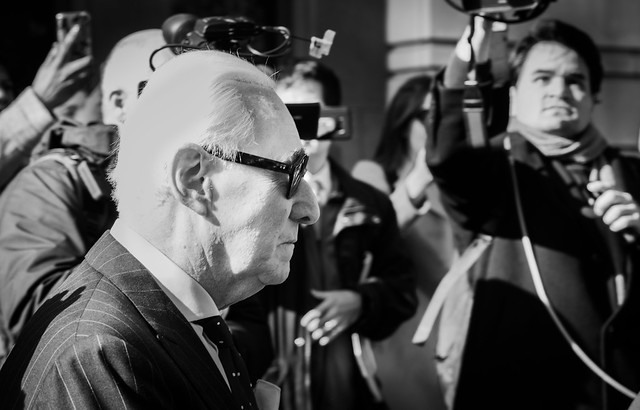Bill Barr’s Secret: He’s Pro-Defendant
Bill Barr gives a gift to criminal defendants everywhere. The defense bar should take it at face value—and thereby make him answer for it.

Published by The Lawfare Institute
in Cooperation With

Memo to defense attorneys everywhere: You’ve got a friend in Attorney General Bill Barr.
The tough-on-crime face the guy puts on is just an act. In reality, Barr is on your side. In fact, it was on his orders that the Justice Department last week advanced a remarkably pro-defendant position in the prosecution of Roger Stone—a position just waiting for countless defense lawyers around the country to try to exploit in their own cases.
Got a client who’s old or in not-so-great health? Barr wants to help.
Got a non-violent client whose sentencing enhancement factors under the Federal Sentencing Guidelines would “disproportionately escalate [his or her] sentencing exposure to an offense level” associated with violent crime? Barr cares.
Did your client’s victim minimize the threat your client posed to him? Barr wants the courts to take account of that in sentencing.
To be sure, Barr seems to only care about such matters when the defendant is—like Roger Stone—a friend of the president and a person indicted in the Mueller investigation. But Barr’s Justice Department in the Stone case did not walk into court and announce that it has one set of standards for Trump associates in cases about which the president comments serially and a completely different set of standards for all other cases. Rather, the Justice Department articulated certain principles—principles that the defense bar now gets to cite in all cases.
A close examination shows those principles to be pretty expansive. Let’s take a look.
On Feb. 10, federal prosecutors filed a sentencing memorandum recommending that Stone receive a sentence of seven to nine years for crimes related to his efforts to hide from Congress his interactions with Wikileaks in the lead-up to the 2016 presidential election. The memorandum asserts that a sentence in the recommended range would be “consistent with the applicable advisory Guidelines.” Importantly, the government has never since contradicted this point.
Back in November, following trial, a jury found Stone guilty of seven felonies: obstructing a congressional investigation in violation of 18 U.S.C. § 1505 (count 1), making false statements to Congress in violation of 18 U.S.C. § 1001(a)(2) (counts 2-6), and witness tampering in violation of 18 U.S.C. § 1512(b)(1) (count 7).
For those readers not familiar with the sentencing guidelines, the guidelines work by assigning a numerical base level to the underlying offense and then adding to or subtracting from that number based on a variety of different factors. In its initial brief, the government concluded that Stone’s total offense level is 29 and that his criminal history category is I, yielding a sentencing range of seven to nine years under the advisory sentencing guidelines.
The government reached this conclusion using a calculation that runs as follows. Under the guidelines, the base offense level for “Obstruction of Justice” (counts 1-7, combined) is 14. Pursuant to the guidelines, eight levels are added because the offense “involved causing or threatening to cause physical injury to a person, or property damage, in order to obstruct the administration of justice.” The sentencing memorandum recounts Stone’s threats, in writing, to keep his longtime associate Randy Credico from testifying truthfully to Congress. The prosecutors contend that although Stone might argue that he did not have a serious plan to harm Credico, Credico testified that the threats concerned him. Regardless, the memorandum emphasizes, the threat itself––not the likelihood of Stone’s carrying out the threat––triggers the enhancement under the guidelines.
In addition, the prosecutors add three levels to Stone’s offense level because the offense “resulted in substantial interference with the administration of justice”: the House Intelligence Committee did not receive important documents and testimony because of Stone’s conduct. And two more levels get added because the offense was otherwise “extensive in scope, planning, or preparation”: Stone engaged in a multi-year scheme that involved making false statements in sworn testimony, concealing important document evidence, lying in written submissions to Congress, and engaging in a “relentless and elaborate campaign” to silence witnesses, the government argued.
Finally, two more levels are added because Stone “willfully obstructed or impeded, or attempted to obstruct or impede, the administration of justice with respect to the prosecution of the instant offense of conviction.” The memorandum recounts an occasion in which Stone posted an image of the presiding judge with a crosshair next to her head and a pretrial release hearing in which Stone gave testimony that was not credible. It also notes that Stone repeatedly violated the judge’s order by posting on social media about the case.
Adding the above levels together, the memorandum concludes that Stone’s total offense level is 29. Under the guidelines, the prosecutors argue, this should translate into a sentence of seven to nine years.
The memorandum also applies to Stone’s case the factors set forth in 18 U.S.C. § 3553(a) for courts to consider in sentencing. The prosecutors argue that the recommended sentence is appropriate because obstructing investigations into foreign election interference concerns issues of paramount concern and because Stone’s efforts were a direct attack on the rule of law. The prosecutors also note that Stone doubled down on his criminal conduct by tampering with a witness for months. Overall, the prosecutors argue, Stone’s conduct displays a low regard for the House Intelligence Committee’s investigation and for this criminal case. The prosecutors then look to the characteristics of the defendant and suggest that Stone’s criminal conduct was undertaken purposefully, not out of desperation. The memorandum concludes that the recommended sentence, consistent with the applicable guidelines range, is appropriate.
Again, although the government subsequently revised its recommendation, the government has never disavowed the first memo’s perfectly routine calculation of what the guidelines suggest—a calculation prosecutors around the country do every day in countless cases. The guidelines, of course, are just that—guidelines, not hard-and-fast rules. Prosecutors have leeway in how they choose to tabulate the factors that might enhance or reduce their recommendation for a defendant’s sentence. But it is rare for prosecutors to recommend a sentence below the guidelines range in the absence of cooperation or dramatically compelling circumstances. And it is quite unheard of for prosecutors, having recommended a guidelines sentence for an unrepentant felon, to turn around the next day and withdraw their previous sentencing recommendation for only vague reasons that defense lawyers are more than capable of raising themselves.
It is an important feature of Barr’s insistence on revising that Justice Department recommendation—which triggered the withdrawal from the case of the four career prosecutors who had been litigating it—that the department does not now take issue with its prior calculations. On Feb. 11, the Department of Justice filed a supplemental and amended sentencing memorandum, suggesting to the court that, while the Sentencing Guidelines enhancements outlined in the first filing were “perhaps technically applicable,” a sentence of incarceration “far less” than seven to nine years would be “reasonable under the circumstances.”
In the second memorandum, the Department of Justice states that § 3553(a) instructs courts to consider several factors in determining a defendant’s sentence––of which the sentencing guidelines range is just one. Quoting the Supreme Court, the department asserts that courts should not presume the range under the sentencing guidelines is reasonable, but rather should make an individualized assessment based on the facts presented. And here, the short memo notes, the sentencing guideline’s enhancements “more than double the defendant’s total offense level,” which “disproportionately escalate[s]” his sentencing exposure to a level more akin to cases involving violent offenses.
In other words, the department is now suddenly conceding that if following the guidelines enhancements would cause a non-violent felon’s sentence to disproportionately escalate to something more apt for a violent felon, a court should take that into account.
Need a cite on this government concession—which will be particularly useful for those of you with fraud cases with high-dollar figures, in which the enhancements really ratchet up fast—for your own brief? See Government’s Supplemental and Amended Sentencing Memorandum, United States v. Stone, No. 19-cr-00018 (D.D.C., Feb. 11, 2020).
In arguing that there are grounds here to depart from the sentencing guidelines, the department points to four mitigating factors—each of which should be useful to the defense bar as well.
First, the department states that the eight-level enhancement for threatening to cause physical injury was disputed by the victim of the threat (Credico), who asserted that he did not perceive a genuine threat. Though the memorandum recognizes that Credico’s perception of the threat is not dispositive to the enhancement, the department now suggests that the court should still consider the victim’s subjective beliefs, particularly because an increase of eight levels is so significant. Presumably, this would still be the case under the department’s reasoning if Credico made this statement only because he was afraid of Stone. This idea should be particularly useful to those defense lawyers with clients who have sufficiently terrorized their victims as to ensure that the victims now defensively minimize the threats to authorities or on the witness stand.
Second, the department proposes that the two-level enhancement for obstruction of justice “overlaps to a degree with the offense conduct in this case,” and it is “unclear to what extent the defendant’s obstructive conduct actually prejudiced the government at trial.” The no-harm, no foul principle has broad application as well. It applies in principle to almost any attempted obstruction that does not succeed.
Third, even while recognizing that other recent obstruction of justice cases cited by the government involved lesser offenses, Barr’s new position nonetheless suggests that the recommended sentence creates unwarranted disparities between those cases and Stone’s. The notion that sentencing in more serious cases should be generally consistent with sentencing in less serious cases is a remarkable one for prosecutors to take. But why not run with it? It’s not like the Justice Department can now deny having said this:
In its prior filing, the Government directed the Court’s attention to a non-exhaustive list of witness tampering, false statement, and obstruction of justice cases that resulted in sentences of thirty months (Libby), thirteen months (Manafort), six months (Lavelle), twelve months (Hansen), and thirty-five months (Solofa). While these cases involved lesser offense conduct, the sentences imposed constituted a fraction of the penalty suggested by the advisory Guidelines in this case.
Finally, the department asks the court to consider Stone’s “advanced age, health, personal circumstances, and lack of criminal history” when determining his sentence. Here prosecutors once again emphasize that the recommended sentence under the guidelines is more typical for defendants with more substantial criminal history or who obstructed justice as part of a violent criminal organization. But the proposition is astonishingly broad. Why should any other court with any other defendant not consider age, health, personal circumstances or lack of prior criminal history in deciding whether the guidelines would give a defendant too much time?
We don’t purport to know how many defendants out there facing sentencing have in their cases all of the factors the government cites in urging a non-guidelines sentence for Stone. But a great many defendants have some of them. And some may have factors more compelling. For example, if the department is now arguing that the combination of age, non-violence, the lack of a prior criminal history, and personal circumstance to be sufficient reason to depart from the guidelines, what about someone who is very young and lacks all the advantages that Roger Stone has had in life? What about someone who is not an older white guy who happens to be a friend of the president but is a non-violent, first-time drug offender? Is the department’s position now that if enhancements would push his sentence into the realm normally reserved for violent offenders, that his youth and personal disadvantages in life, the fact that his attempted obstructions didn’t quite succeed, and the fact that other people who did less than he got less time should now argue for a lesser sentence?
We think the defense bar should test the limits of Barr’s new-found compassion for criminal defendants. The department should have to answer for this brief in every case in which the principles it articulates have reasonable application, either individually or collectively. Judges should take note too. If in these other cases, the department doesn’t stand by them and support similar sentencing leniency to what it advocated in Stone, judges should ask why.
This will, of course, be unfair to the line prosecutors handling those cases. But this is a position their department took. And they don’t have to show up in court and answer for it. If they feel undermined by what the attorney general has done, like the prosecutors in the Stone case, they too can withdraw and decline to engage in the contorted justifications—and consequent loss of credibility—the second Stone memorandum now demands.
The bottom line is that we should find out whether the principles the government is articulating in Stone are principles at all, or whether they apply only to those defendants for whom the president has solicitude and in cases he decries as witch hunts.






